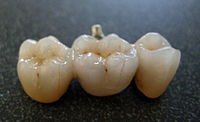
Photo from wikipedia
OBJECTIVES To test whether the load-bearing capacity of occlusal veneers made of ceramic or hybrid materials bonded to dentin does differ from those of porcelain-fused-to metal or lithium disilicate glass… Click to show full abstract
OBJECTIVES To test whether the load-bearing capacity of occlusal veneers made of ceramic or hybrid materials bonded to dentin does differ from those of porcelain-fused-to metal or lithium disilicate glass ceramic crowns. MATERIAL AND METHODS In 80 human molars, occlusal tooth substance was removed so that the defects extended into dentin, simulating defects caused by attrition/erosion. Restorations at a standardized thickness of either 0.5 mm or 1.0 mm were digitally designed. For both thicknesses, 4 test groups (n = 10 per group) were defined, each including a different restorative material: "0.5-ZIR": 0.5 mm thick zirconia (Vita YZ HT); "1.0-ZIR": 1.0 mm thick zirconia (Vita YZ HT); "0.5-LDC": 0.5 mm thick lithium disilicate ceramic (IPS e.max Press); "1.0-LDC": 1.0 mm thick lithium disilicate ceramic (IPS e.max Press); "0.5-HYC": 0.5 mm thick PICN (Vita Enamic); "1.0-HYC": 1.0 mm thick PICN (Vita Enamic); "0.5-COC": 0.5 mm thick tooth shaded resin composite (Lava Ultimate) and "1.0-COC": 1.0 mm thick tooth shaded resin composite (Lava Ultimate). Consecutively, the specimens were thermo-mechanically aged and then loaded until fracture. The load-bearing capacities (Fmax) between the groups were statistically compared using the Kruskal-Wallis test (p < 0.05) and pairwise group comparison applying the Dunn's method. In addition, the results were compared to those of conventional lithium-disilicate ceramic crowns ("CLD") and to porcelain-fused to metal crowns ("PFM"). RESULTS The median Finitial values for the 0.5 mm thin restorations were 1'350 N for 0.5-ZIR, 850 N for 0.5-LDC, 1'100 N for 0.5-HYC and 1'950 N for 0.5-COC. With CLD as the control, a significant difference was found between the groups 0.5-COC and 0.5-LDC (KW: p = 0.0124). With PFM as the control, the comparisons between PFM and 0.5-LDC as well as between 0.5-COC and 0.5-LDC were significant (KW: p = 0.0026). Median Fmax values of 2'493 N in the group 0.5-ZIR, 1'165 in the group 0.5-LDC, 2'275 N in the group 0.5-HYC and 2'265 N in the group 0.5-COC were found. The medians of the Finitial values for the 1.0 thick restorations amounted of 2'100 N in 1.0-ZIR, 1'750 N in 1.0-LDC, 2'000 N in 1.0-HYC and 2'300 N in 1.0-COC. Testing the multiple comparisons with Dunn's method no significant differences were found (p > 0.05). The median Fmax values of the 1.0 mm thick restorations were: 2'489 N in the group 1.0-ZIR, 1'864 N in the group 1.0-LDC, 2'485 N in the group 1.0-HYC and 2'479 N in the group 1.0-COC. With CLD as the control group, a significant difference between zirconia and lithium-disilicate was found for the 0.5 (p = 0.0017) and 1.0 mm (p = 0.0320) thick specimens. Comparing the 0.5 mm thick specimens with CLD as the control, a significant difference was found between 0.5-HYC and 0.5-LDC (p = 0.0017). With PFM as the control, the comparison of lithium disilicate and zirconia was statistically significant for both thicknesses (p = 0.0009 for the 0.5 mm thick specimens; p = 0.0074 for the 1.0 mm thick specimens). In addition, with PFM as control group, significant differences were seen between 0.5-LDC and all other groups with restorations in 0.5 mm thickness (p = 0.0017). CONCLUSIONS Regarding their maximum load-bearing capacity, minimally invasive occlusal veneers made of ceramic, hybrid materials or polymeric materials can be applied to correct occlusal tooth wear with exposed dentin and thus replace conventional crown restorations in cases of normally expected intraoral bite forces.
Journal Title: Journal of the mechanical behavior of biomedical materials
Year Published: 2019
Link to full text (if available)
Share on Social Media: Sign Up to like & get
recommendations!